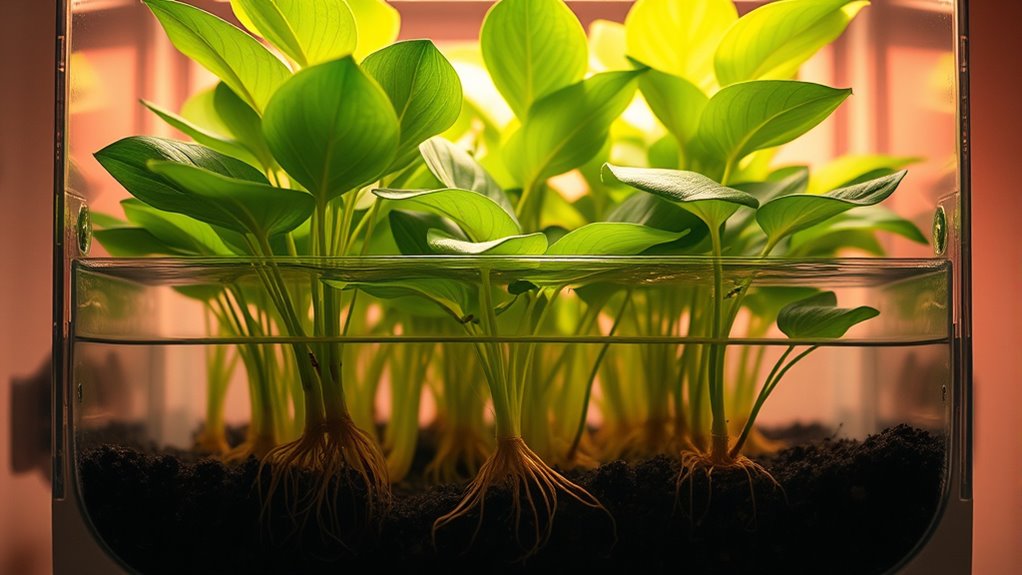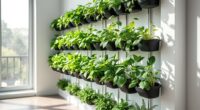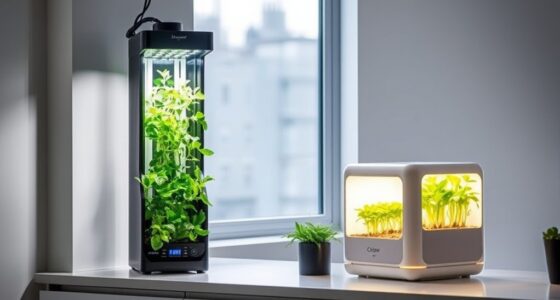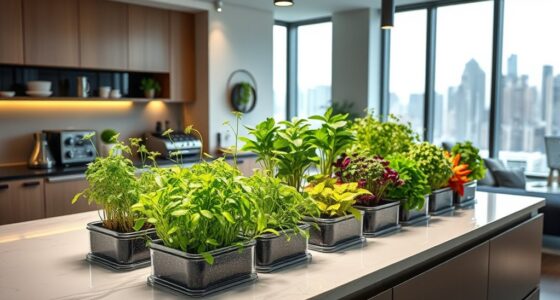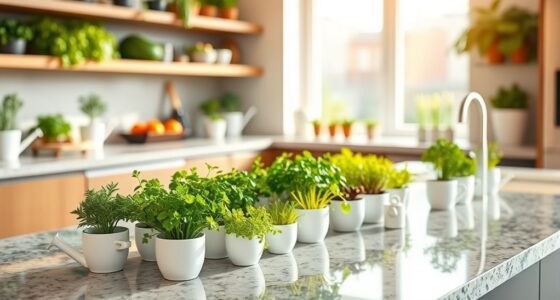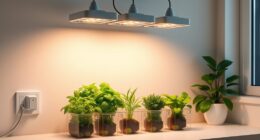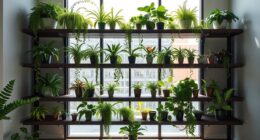Self-watering indoor gardens use reservoirs to store water, releasing it through automated systems that adjust messaging based on soil moisture sensors. These sensors monitor your plant’s needs, triggering precise water delivery and controlling flow with timers. This tech keeps plants consistently hydrated, reducing manual effort and preventing overwatering. As you explore further, you’ll discover how these systems optimize plant health with minimal maintenance and innovative features that work behind the scenes.
Key Takeaways
- Self-watering gardens use reservoirs and water sensors to provide consistent moisture levels for plants.
- Automated systems control water delivery based on soil moisture readings, reducing manual watering.
- Reservoir size and water quality directly impact refill frequency and plant health.
- Control mechanisms and timers synchronize watering with light exposure for optimal growth.
- Regular maintenance, including reservoir cleaning and system checks, ensures efficient operation and healthy plants.
The Role of Reservoirs and Water Storage
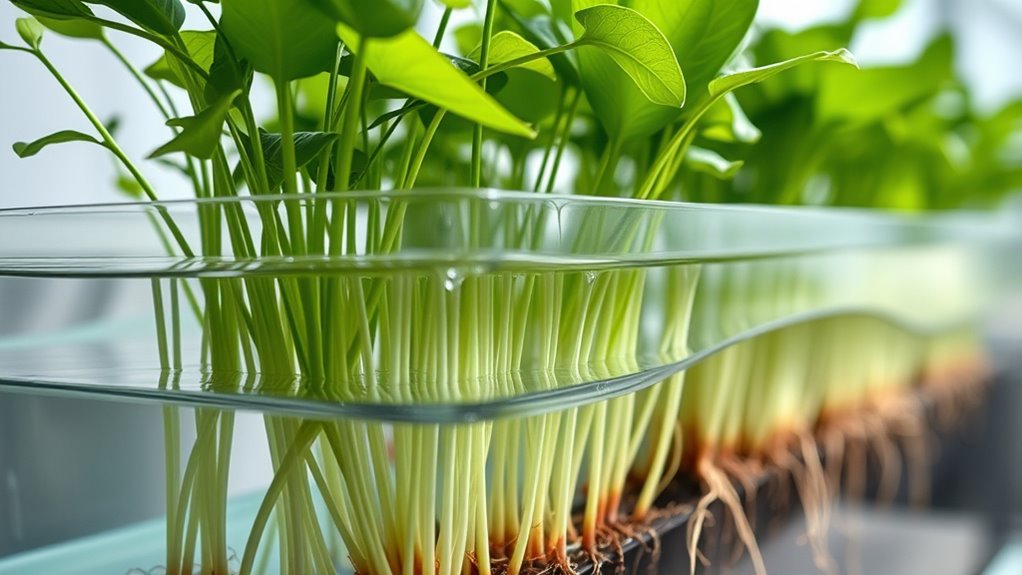
Reservoirs and water storage are essential components of self-watering indoor gardens because they guarantee a consistent supply of water to your plants. Your garden’s reservoir capacity determines how often you’ll need to refill it, impacting maintenance and plant health. A larger capacity reduces the frequency of refills, making your gardening experience more convenient. Equally important is water quality; clean, filtered water prevents algae growth and clogging of the system’s mechanisms. Using high-quality water ensures your plants get the best nutrients and reduces the risk of disease. Properly managing reservoir size and maintaining water quality are key to keeping your indoor garden thriving. Additionally, incorporating AI-driven diagnostics can help monitor water levels and quality in real-time, further optimizing your self-watering system. When these elements work together, they create a reliable, efficient self-watering system that keeps your plants healthy with minimal effort.
Moisture Sensors and Soil Monitoring
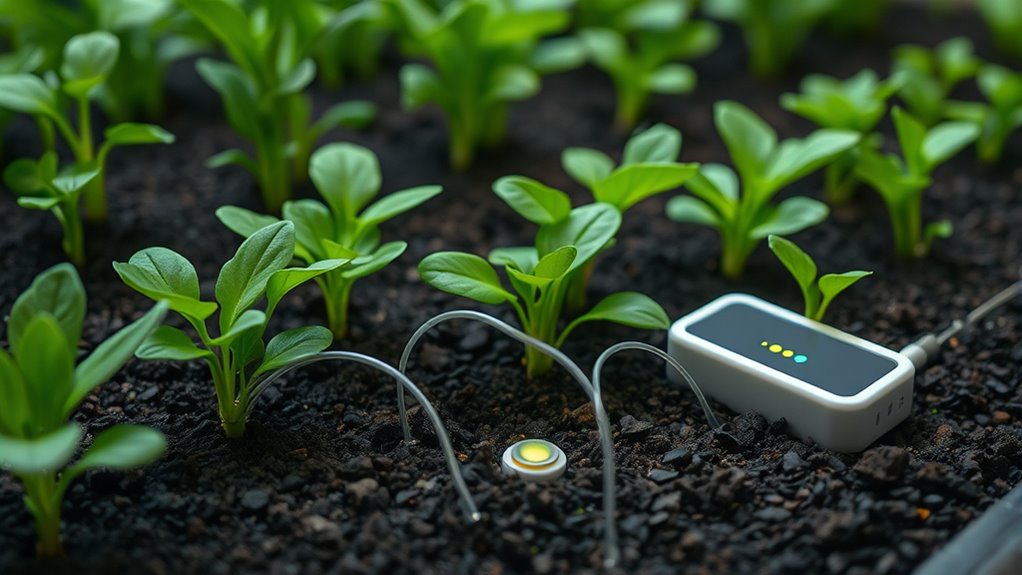
Moisture sensors and soil monitoring tools play an essential role in maintaining the health and efficiency of your self-watering indoor garden. They help you track soil moisture levels, guaranteeing your plants receive just the right amount of water. These sensors can also assist with plant nutrient analysis by detecting deficiencies that affect growth, allowing you to adjust feeding schedules accordingly. Additionally, they support light optimization by monitoring soil health in relation to light exposure, helping you position your garden for maximum photosynthesis. With real-time data, you can prevent overwatering or underwatering, promote healthy root development, and optimize overall plant growth. Using moisture sensors effectively ensures your indoor garden stays balanced, vibrant, and productive with minimal effort. Incorporating cultural considerations, such as understanding the natural preferences of your plant species, can further enhance your garden’s success.
Automated Water Delivery Systems
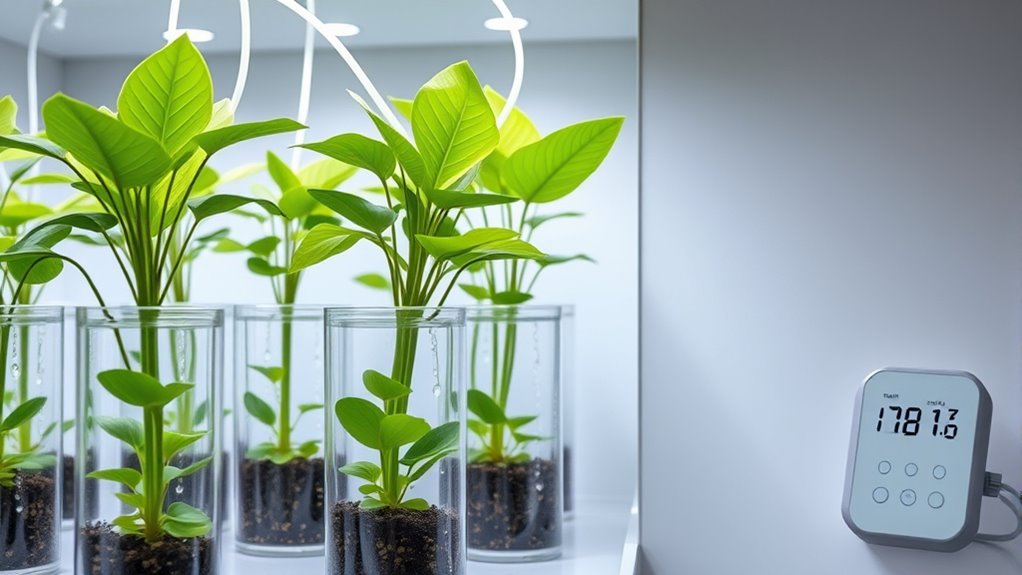
Automated water delivery systems streamline the process of maintaining consistent moisture levels in your indoor garden by precisely controlling when and how much water is supplied. This ensures your plants receive the best plant nutrition, preventing both overwatering and dehydration. By delivering water at the right moments, these systems support healthy root development and vigorous growth. Additionally, consistent moisture helps maximize light utilization, as healthy plants absorb light more efficiently. Automated systems reduce the need for manual watering, allowing your garden to thrive with minimal effort. They work seamlessly with sensors to adapt to your plants’ needs, providing a steady supply of water that promotes lush foliage and vibrant blooms. Incorporating power-efficient equipment ensures your garden remains sustainable and cost-effective over time. Overall, these systems create an ideal environment for your indoor garden to flourish effortlessly.
The Control Mechanisms and Timers
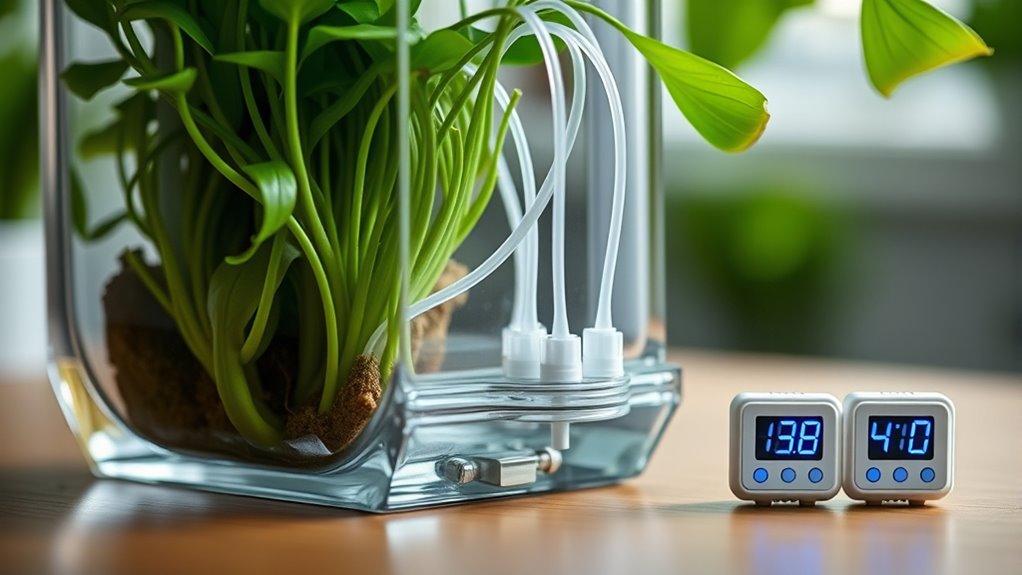
Control mechanisms and timers are essential components that regulate when and how much water your indoor garden receives. They ensure your plants get consistent moisture, supporting ideal plant nutrition and healthy growth. Timers automate watering schedules, preventing over- or under-watering, while control mechanisms adjust water flow based on soil moisture levels. Some systems incorporate light enhancement features, adjusting watering times to align with your plants’ light exposure and growth cycles. This synchronization helps plants absorb nutrients efficiently and supports photosynthesis. Additionally, self-watering system design plays a crucial role in maintaining optimal moisture levels, further reducing the need for manual intervention. By precisely managing watering and lighting, these components keep your garden thriving without constant supervision. As a result, your plants stay healthier, grow faster, and require less manual intervention, making self-watering gardens a convenient and efficient solution for indoor gardening enthusiasts.
Benefits and Maintenance of Self-Watering Gardens
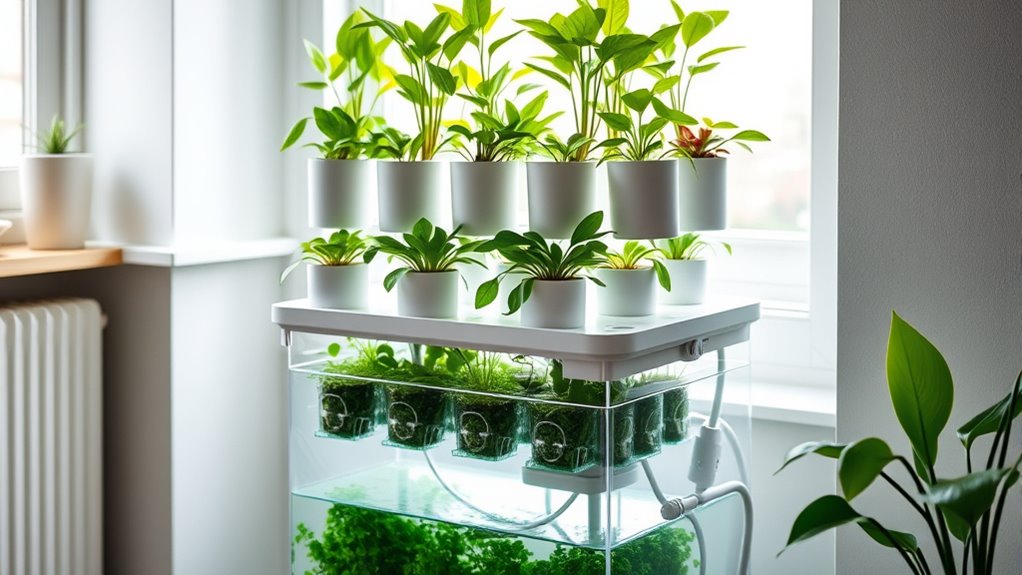
Self-watering gardens offer numerous benefits that make indoor gardening more convenient and rewarding. They promote consistent plant nutrition by providing steady water supply, reducing the risk of overwatering or underwatering. This helps keep plants healthy and vibrant. Additionally, self-watering systems can aid in pest prevention, as they reduce excess moisture that attracts pests. Maintenance is straightforward: check water levels regularly, clean reservoirs periodically, and ensure the system’s components are functioning properly. Proper upkeep guarantees ideal performance and plant health. Here’s a quick overview:
| Aspect | Benefit |
|---|---|
| Plant nutrition | Consistent watering supports healthy growth |
| Pest prevention | Less excess moisture minimizes pest issues |
| Maintenance | Regular checks keep the system running smoothly |
Furthermore, integrating best techniques can optimize system efficiency and ensure your indoor garden thrives.
Frequently Asked Questions
How Long Do Self-Watering Gardens Typically Last Before Needing Replacement?
Self-watering gardens usually last around 1 to 3 years before needing replacement, depending on maintenance frequency and system durability. You’ll want to regularly check water levels and clean the system to extend its life. The better you care for it, the longer it’ll work. Typically, high-quality models last closer to three years, but cheaper options might need replacing sooner. Keep up with maintenance to maximize your garden’s lifespan.
Are There Specific Plant Types Best Suited for Self-Watering Systems?
Did you know 80% of indoor gardeners find self-watering systems perfect for low-maintenance plants? You’ll love how succulents thrive in these setups due to their drought tolerance, making them highly compatible. Flowering plants also do well, offering vibrant blooms with consistent moisture. If you choose the right plants, your self-watering garden becomes a hassle-free way to enjoy lush greenery and colorful flowers effortlessly.
Can Self-Watering Gardens Be Used Outdoors or Are They Only Indoor Systems?
You can definitely use self-watering gardens outdoors; many models are designed for outdoor adaptation. They offer weather resilience, allowing your plants to stay hydrated even during dry spells or rain. Just make certain you choose a system suited for outdoor conditions, with durable materials and protection from extreme weather. This way, you enjoy the convenience of self-watering technology both inside and outside, keeping your plants healthy and well-watered year-round.
What Happens if the Water Reservoir Runs Out Unexpectedly?
You might wonder what happens if your self-watering garden’s reservoir runs out unexpectedly. The truth is, without proper reservoir maintenance, your plants could experience drought stress. To prevent this, some systems include an emergency backup, like an additional water source or an alarm alert. Regularly checking the reservoir guarantees your plants stay healthy, and having a backup plan helps avoid surprises that could harm your indoor garden.
Are There Energy Consumption Concerns With Automated Watering Systems?
You might wonder if automated watering systems use a lot of energy. Generally, they’re designed with energy efficiency in mind, minimizing power consumption while maintaining ideal plant care. These systems often feature low-energy components like timers and sensors that only activate when needed. So, you don’t have to worry much about high power consumption; they’re built to save energy while keeping your plants healthy.
Conclusion
Imagine your garden as a silent but diligent gardener, always tending to your plants like a modern-day Sisyphus with a never-ending task. Self-watering systems take that burden off your shoulders, working tirelessly like a loyal companion. With smart sensors and timers, your indoor garden thrives effortlessly. Embrace this tech, and watch your plants flourish, turning your space into a lush oasis—proof that even in the digital age, nature’s beauty can be seamlessly nurtured.
